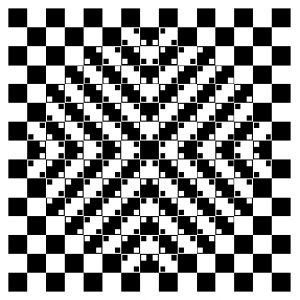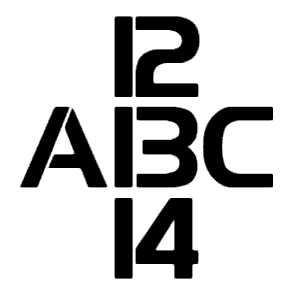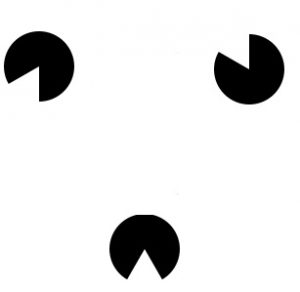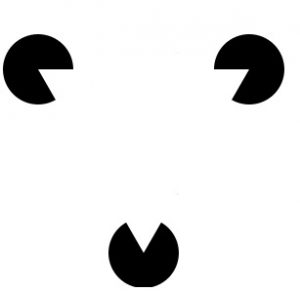Key idea #1
One’s internal experience of the matter and energy in the universe is uniquely constructed.
Copyright Akiyoshi Kitoaka 1998
All lines are straight.
To prove it: Click the image, scroll your page to the middle of the image and
use the top and sides of your window as rulers.
Perception and “reality”
A few weeks ago I stopped at a new café to grab a coffee on my way to a workshop. As I headed towards the open door I waited for the people outside to pass then walked out – straight into a glass wall! What I thought was an open space wasn’t. Fortunately, the glass didn’t break and only a few of my skin cells did. And, my Keep-Cup lived up to its name. 😉
The actual door was painted the same colour as the wall, so my distracted brain used the fact that I could see people walking past the café as evidence there was an open door. From my perspective that opening was definitely a space to walk through, while from the perspective of the café workers (and probably everybody else in the café) it was a glass wall. I was pretty quickly convinced my version of reality was not accurate!
The point of this little story is that my brain was deceived by my senses and I had no prior experience of that café to better inform the sense making. I was not consciously thinking “how do I get out?” or “where is the door?”. My unconscious mind, acting on my desire to get back to my car, showed me the fastest route to that objective using the best data it had available and assumed the space in front of me with people on the other side was, in fact, the way out.
The origins of “reality”
Reflect on this: every single piece of information about the world outside our bodies, and indeed those things we are aware of within our bodies, is transmitted to our brain via our senses.
We have no access to the world that is not mediated through the parts of our bodies built as detectors of the “world” (exteroception). Similarly, hunger, thirst, the weariness of our muscles or the pounding of our heart can only be known in our brain because of the internal sensory mechanism that transmits our state of being (interoception). Finally, our place in space – “what is the position of my arm right now in relation to my body?” is informed by detectors in our joints and muscles (proprioception).
All the signals from all that detection eventually reaches the brain where is it processed. Most of the response to that processing occurs unconsciously – signals are sent to organs, hormones are released, muscles contract or release, etc.
Now, consider sight: photons bounce off the objects in the world outside us and some of them collide with the photo-receptors on our retina. Those photo receptors convert the information from the photons into chemical-electrical signals that passed down the optic nerve to reach various areas within our brain. Those various areas are responsible for subsets of what we call vision. These include calculations of contrast, colour, slope, whether the object is moving away or towards us, size, speed, etc. Finally, the outcome of each of those sub calculations reaches the visual cortex and it is only at that moment we have the conscious experience of “seeing”.
Context is everything
The construction of reality
In a biological sense what we see is constructed by our brain – it is a representation based partially upon information coming through the detectors of light which are our eyes.
The “partially” bit of that previous phrase it is vitally important when we consider our experience of “reality” because what we know for sure is that we only “see” a very small proportion of the information originating in those photons in the world around us. It has to be that way, or we would not be able to function effectively in the world. It takes more than 250 milliseconds to process that very small proportion of the available visual information before it appears in our mind. Imagine how dangerous a longer delay would be for our existence. For our survival we must choose what to make the focus of our attention and what to delete from conscious awareness. Some pieces of that visual information are deemed more important and relevant than others. In that 250 milliseconds, parts of our brain decide which bits to present to consciousness and consequently that is what we “see. That is our visual “reality” – a constructed experience.
The only difference between the two images is the rotation of the “Pac Men”
Magically a triangle is implied in the second image.
Your brain is constructing “a triangle” that is not there.
The processing of sound waves impacting the detectors in our ears passes through a similar set of processes to construct what we hear. A similar process occurs for all conscious experience of incoming information – smell, taste, touch, etc.
In other articles I will describe what I consider to be the essential implications of the constructed nature of reality for self and leadership development, including ideas about how the brain “decides” what to present to consciousness.
For now, the key point is: our experience of “the real world” is a construction of our brains.
Here are a few examples of the evidence supporting the idea of constructed experience.
Perceptome, How perceptions create reality: Luis M. Martínez at TEDxBarcelona
https://www.youtube.com/watch?v=LsBWLHc2ezY
Optical illusions show how we see
https://www.ted.com/talks/beau_lotto_optical_illusions_show_how_we_see
Time and the brain: the illusion of now | Hinze Hogendoorn | TEDxUtrechtUniversity
https://www.youtube.com/watch?v=BEuNa1Vp_b0
Seeing the world as it isn’t | Daniel Simons | TEDxUIUC
https://www.youtube.com/watch?v=9Il_D3Xt9W0
Your perception is not always reality | Nikos Konstantinou | TEDxNicosia
https://www.youtube.com/watch?v=hbmqku_jpHg
Why the world does not exist | Markus Gabriel | TEDxMünchen
https://www.youtube.com/watch?v=hzvesGB_TI0
Three visual illusions that reveal the hidden workings of the brain
http://theconversation.com/three-visual-illusions-that-reveal-the-hidden-workings-of-the-brain-80875
The illusion of usability — perception, simulation and culture: Ben Bogart at TEDxMünchenSalon




